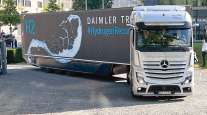Daimler Seeks One US-EU Truck Standard, Questions Long-Term Viability of Nat Gas
This story appears in the April 7 print edition of Transport Topics.
LOUISVILLE, Ky. — The head of Daimler AG’s global truck and bus operations called on the supplier community to push U.S. and European regulators for a single standard for fuel economy and greenhouse-gas emissions.
Wolfgang Bernhard, who made the comments during a speech and media round table at the Mid-America Trucking Show here, also warned California regulators against further nitrogen oxides rules and cast doubt over the long-term viability of natural gas as a trucking fuel.
“My call is to please join us in urging [the Environmental Protection Agency] to tighten the screws that create the most leverage,” he said of the next phase of greenhouse-gas regulations. “GHG is not just an engine thing, or a transmission thing, or an axle thing. It is the whole system combined that makes the difference.”
The U.S. government developed the greenhouse-gas rule that set standards for truck fuel economy and carbon dioxide emissions, first for 2014 and then for 2017.
However, in February, President Obama ordered the development of a proposed rule by March 2015 to further tighten greenhouse-gas emissions and to complete the process a year after that.
Bernhard, who took his post one year ago, addressed more than 900 people at the Heavy Duty Manufacturers Association’s breakfast briefing March 28. He emphasized the practicality of common emissions standards for the United States and European Union.
“Regulators on each side [of the Atlantic] must dock their egos in the loading dock,” he said. “Why not accept the other guy’s standard for a couple years?”
Having one standard could provide a significant savings on parts and testing. “We could put that money to much better use” in other research and development endeavors, he said, adding that “a common standard does not mean a lower standard.”
Susan Alt, a senior vice president with Volvo Trucks, said the company strongly backs the idea of a single, total-vehicle standard.
Bernhard also called upon the United States and the European Union to “create trade agreements that allow us to freely export and import goods,” in order to counterbalance growing competition from Asia.
“There is a historic opportunity to strengthen our unique bonds across the ocean,” he said of the ongoing Transatlantic Trade and Investment Partnership talks. “We cannot afford to lose this opportunity.”
Bernhard added that further regulation targeting nitrogen oxides would be “disastrous,” and that they would be nearly impossible to measure accurately.
Though EPA appears to understand what is at stake, the California Air Resources Board “is not getting that message,” he said.
As recently as December, CARB was considering developing optional low oxides of nitrogen diesel emission standards for heavy-duty vehicles for model years 2010 and later.
“We are giving customers what they want to buy,” Bernhard said. “The customers are saying they like it, and they are paying for it. If EPA goes beyond the point customers will pay for, it will be making a mistake.”
Bernhard also urged lawmakers to play a role in reducing emissions by increasing highway funding.
“Better surface infrastructure means less traffic jams,” he said, adding the most fuel-efficient truck “can’t do much good” if it is stuck idling in traffic.
Looking ahead, he insisted he does not see “any replacement for diesel.”
While sales of natural gas-powered trucks in the United States continue to creep higher, he said “the hype is gone, and there is more realism” setting in about fueling infrastructure and long-term performance.
“I don’t see any longhaul applications,” he said of natural gas, though urban and local dedicated runs could benefit.
He also questioned whether current natural-gas engines “are up to the task of hauling long distances.”
After offering a positive outlook on the North American market, he said the global picture was mixed.
In Europe, orders have been fairly weak after a pre-buy. Orders in Japan, meanwhile, have been positive, driven by a pre-buy to beat an upcoming tax increase.
In South America, a spillover from the Federal Reserve’s decision to decrease growth in the U.S. money supply was causing some weakness in Brazil and Argentina. Likewise, the Russian market is down due to the political turmoil involving Ukraine.
Beyond North America, Bernhard said, “the biggest growth the next couple of years will be in emerging markets.”
There will be a need for 600,000 more trucks from markets through 2020 in countries such as Indonesia.
“There are plenty of opportunities out there, and we are going after it,” he said.
One example is India, where the company’s BharatBenz brand has proved successful in less than two years, letting established competitors know “we are continuing our journey toward becoming a major player.”
Bernhard noted Daimler is beginning to export these vehicles in small numbers to limited markets in Africa.




